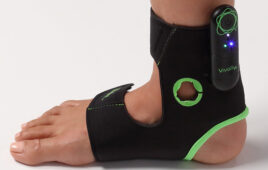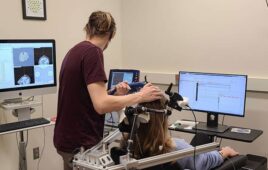Oral bacteria from poor dental hygiene have been linked to brain tissue degeneration, according to new evidence from an international team of researchers, including one at the University of Florida College of Dentistry.
UF’s Lakshmyya Kesavalu, B.V.Sc., M.Sc., S.C.C., an associate professor in the College of Dentistry department of periodontology, and researchers from the University of Central Lancashire and The Blizzard Institute in the United Kingdom examined samples from the brains of patients with and without dementia. Lipopolysaccharide, a component of Porphyromonas gingivalis, an oral bacterium, was found in four out of 10 Alzheimer’s disease brain samples. It was not found in any samples from the brains of people who did not have Alzheimer’s disease.
“This clearly shows that there is an association between oral bacteria and Alzheimer’s disease, but not causal association,” Kesavalu said.
Oral bacteria can enter the bloodstream during chewing, brushing and flossing, and during dental procedures. The bacteria, researchers believe, can enter through the bloodstream to the brain and can potentially lead to degeneration in brain tissue that appears similar to Alzheimer’s disease.
The research, led by senior author StJohn Crean, B.D.S., M.B.B.S., Ph.D., dean of the College of Medicine and Dentistry at the University of Central Lancashire, is the first study to show a link between the existence of the oral bacterium component lipopolysaccharide and Alzheimer’s disease. The paper was published in the Journal of Alzheimer’s Disease.
The study follows work at UF on mice infected with four major periodontal pathogens. In that unpublished study, the researchers found the oral bacterium moved to the brain in the mice as well, further confirming the group’s research on humans.
Gingivitis is seen in 97 percent of the population, Kesavalu said. It is one of the most common diseases to affect humans, more common than the common cold. According to the Centers for Disease Control and Prevention, about 64 percent of seniors age 65 and over have moderate or severe periodontal disease. Alzheimer’s disease, according to the Alzheimer’s Association, is the sixth leading cause of death in the United States — affecting more than 5 million Americans.
The brain disease costs the U.S. both money and lives. One in three senior citizens dies from Alzheimer’s or another form of dementia. In 2013 Alzheimer’s is projected to cost the country $203 billion, according to the Alzheimer’s Association.
“Right now, globally about 36 million people are affected by Alzheimer’s disease (according to the World Health Organization) and it may go up to 115 million by 2050,” Kesavalu said.
According to the study, researchers think the bacterium found in the brain can trigger immune system responses and pathological changes, which may lead to diseases such as Alzheimer’s. Researchers studied the brain tissue of 10 Alzheimer’s patients and compared it with that of 10 non-Alzheimer’s brain samples. A special type of test called immunofluorescence labeling and immunoblotting was used to screen the brains and find lipopolysaccharide.
Although the findings do not prove that oral bacteria causes Alzheimer’s disease, preventing gum disease is still a good idea, and there are easy steps to take to do this, Kesavalu said.
“People should brush their teeth regularly twice a day. Second, they can floss their teeth regularly so there are no bacteria plaques between teeth, and third, they can visit their dentist for regular cleanings. Fourth, not smoking,” he said.
So what’s next in Kesavalu’s research?
“Having demonstrated oral bacterium components in Alzheimer’s disease brains, we are planning to study the causal association between major periodontal bacteria and Alzheimer’s disease in mouse models,” he said.




